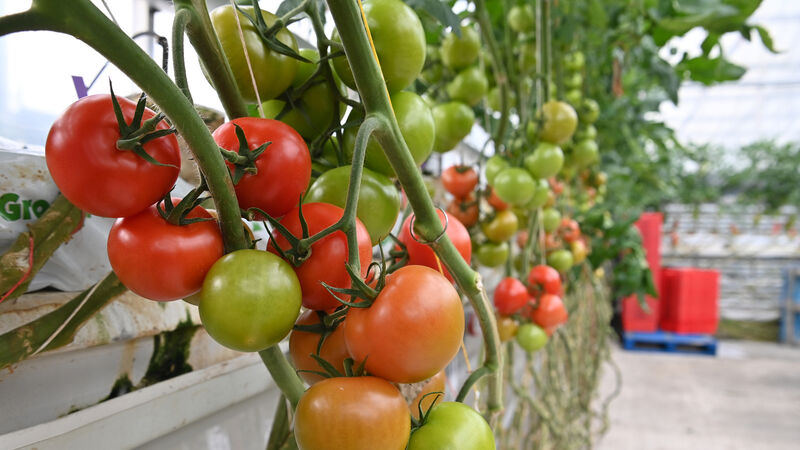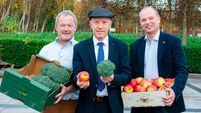An Irish tomato grower who feared a delayed start to his 2023 season has said that horticulture is a “challenging sector to be involved in”, especially in the last year, but he is hopeful of an easing of input price increases going forward.
In October, the Irish Examiner reported that Grantstown Nurseries, based in Ballygunner outside Waterford City, was considering its next moves as the Dutch plant raiser it had worked with for many years announced that it was winding down due to the impact of input costs on the business.
David Currid, who runs Grantstown Nurseries, was, along with other Irish growers, left scrambling to find a plant propagator only weeks out from the beginning of the next growing season.
Every January, the business would have its plants delivered from the Netherlands when they are about 1ft tall, having been raised by a company called Plantise, which carried out the specialist job.
Mr Currid explained that the seed is sown in the Netherlands in mid-November, then those plants would arrive at Grantstown Nurseries in early January, and the crop would then be in situ the following day in the glasshouses, all spaced out about 50cm apart.
With tomatoes being a single-season crop, it is an annual plant that has to be replaced every year.
Mr Currid said they had been dealing with Plantise, which was one of the top three cultivation companies in the Netherlands, for over 20 years.
The company’s chief executive, Marco Vermeulen, confirmed to the Irish Examiner that the last of its plants will be delivered in March 2023.
Mr Vermeulen said that signed orders made before October 1, 2022, for plants to be delivered in January would be honoured, but that no orders after this date were taken.
Plantise had a total of seven Irish customers at the time.
On the back foot
“We had to go and reach into our contacts book and, with the help of contacts in Holland, find a suitable alternative plant propagator to supply our plants for the 2023 season,” Mr Currid explained.
“Certainly, having those contacts helped a lot in making introductions to us at very short notice to try and get an order placed and find a company that was willing to take on our business.
“A lot of the companies would have had regular clients over the years and obviously they had first preference on the space available.”
Through the process of “lots of phone and Zoom calls”, Grantstown Nurseries is now working with a company called WPK, from which they received 16,000 plants recently.
“We were on the back foot so we kind of had to accept more or less what we were offered and, in fairness, they charged us pretty much the going rate for the plants,” Mr Currid said.
“Our seeds were sown in late October but the downside was that normally we’d take plants in mid-January, and that was our plan for this year, but because of their schedule being booked solid for that period, we had two options — take plants in before Christmas, or take them in February.
“February wasn’t really an option for us, what would you do during that period of time just hanging around waiting for plants?
“We took the decision, we just had to grasp the nettle and place the order for delivery on December 20.”
And instead of planting later to save costs, particularly in relation to energy, Mr Currid ended up “having to plant three weeks earlier than planned, so obviously the knock-on effect there are extra costs incurred with energy”.
However, he said, “it was the lesser of two evils, and we just had to go with it”.
“Everything arrived intact, no issues with it, and the plants are in our glasshouses now since December 21,” he added.
At the mercy of the weather
Mr Currid said that his business, which grows around 250 tonnes of tomato varieties in one hectare of modern glasshouses, is very happy with the plants received for this year.
“Also, we have been fortunate that the weather has been relatively kind to us since that period as well because it’s been so mild and normally when it’s mild in the winter in Ireland it’s dull, but we’ve had decent levels of sunshine,” he explained.
“Sunshine is the most important factor for young tomato plants; we can control the majority of things but we can’t make the sun shine.
“If we don’t get bright days, it doesn’t get the crop off to a great start, but thankfully it has been reasonably bright and we have had enough sunlight to satisfy the plants so far.”
In theory, since Mr Currid received the plants earlier, the tomatoes should be on the shelves earlier, but it is weather-dependent, he said.
“Bringing in plants in the last days of December, the shortest days of the year, it’s not ideal,” he explained.
“But once you get into January, the days begin to lengthen a little bit and generally you get better sunshine.
“While we started our crop three weeks earlier than we had planned to do, we’ll probably come into production —weather-dependent — maybe 10 days ahead of last year.
“We’re at the mercy of the weather really all the time, but particularly this year with having to take plants earlier.”
A challenging sector to be in
In a normal year, they would have a few red tomatoes around St Patrick’s Day, and they would start selling them the last week of March when they would have enough volume to start supplying the retailers.
“Hopefully we should have some red tomatoes at the beginning of March and we’d be hopeful we would have some Irish tomatoes on the shelves around St Patrick’s Day,” Mr Currid said.
With only around seven commercial tomato growers left in Ireland, Mr Currid said that despite the significant challenges the sector faces in Ireland, “we have commitments made and we have staff to keep employed, so we feel obliged to keep the business on the road and keep going”.
“Hopefully we can write off 2022 as being a tough year; 2023 is probably not going to be a lot better, but with the support of our customers, retailers, and some state aid too through the Horticulture Exceptional Payment Scheme that we availed of in 2022, we’re hopeful that we can get through 2023 and maybe some normality will return to input costs, particularly energy,” he said.
“Everybody has the same challenges, but with input costs rising at the rate that they’ve done over the last two years, and things maybe are beginning to kind of plateau a little bit but still, energy costs are at the minute running around three times the cost they were in 2021 so it’s very difficult.
“It’s a challenging sector to be involved in, particularly as we’re dependent on energy so much, but everything — fertiliser, packaging, labour — is increasing in cost.”
Cheap food model
Mr Currid feels that there is “definitely an appreciation” for Irish-grown produce amongst consumers, and particularly since the Covid-19 pandemic, “people became more aware of where produce is coming from”.
“Unfortunately, the retail model in Ireland is for low cost, it’s a cheap food model, and really as long as that continues, it’s going to be difficult for growers to remain sustainable from an economic point of view,” Mr Currid said.
“As growers, we have to keep evolving and introducing new varieties, new lines, and trying to add value to what we’re doing through innovation.”
Bord Bia told the Irish Examiner that growing tomatoes is a highly specialist horticultural enterprise and that there would be no more than 10 tomato high-wire glasshouse growers of any significant scale in the country.
There are 12 hectares of tomatoes grown in the country, according to Bord Bia’s data.
In 2021, the average yield was 314 tonnes per hectare, up from 309 tonnes per hectare in 2020.
Production was 3,768 tonnes in 2021, compared to 3,710 tonnes in 2020.

Unlimited access. Half the price.
Try unlimited access from only €1.50 a week
Already a subscriber? Sign in












